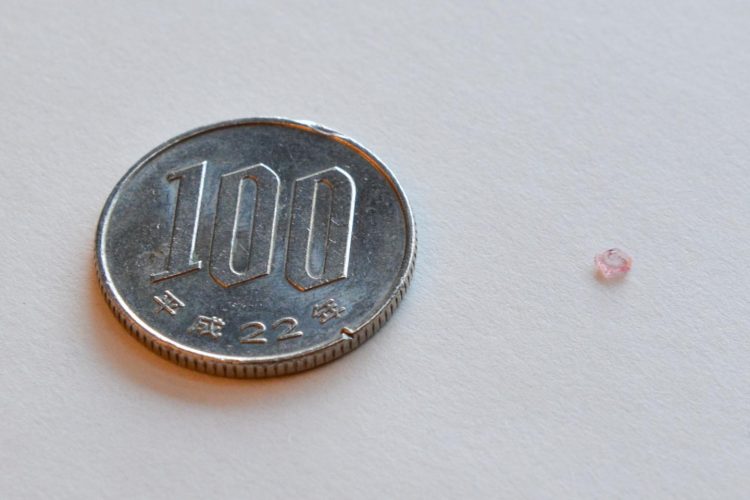The quantum middle man

A crystal made of manganese and other elements that provides a strong hyperfine interaction between the nucleus and electrons is just a few millimeters wide. It is shown next to a 100 Yen coin for scale. Credit: OIST
Quantum computing — which aims to use particles on the atomic scale to make calculations and store the results — has the potential to solve some key problems much faster than current computers.
To make quantum computing a reality, scientists must find a system that remains stable long enough to make the calculations. While this is an extremely short time frame, only thousandths of a second, the particles involved are so small that they are easily influenced by their surroundings. If the motion of the particles is disturbed, even a little, it throws off the whole calculation.
Nuclei are promising contenders for quantum memory because they are not easily influenced by their surroundings. However, that also makes them extremely difficult to manipulate. Many quantum physicists have tried with little success.
“In usual materials it is very difficult to control nuclei directly,” said Prof. Denis Konstantinov, who runs the Quantum Dynamics Unit at OIST.
Instead of trying control the nucleus directly, the researchers focused on a “middle man” of sorts – the electrons orbiting the nucleus.
The nucleus has a tiny internal magnet, called a “magnetic moment,” and the electrons orbiting around it also have magnetic moments that are about 1,000 times larger. Those magnets interact with each other, which is called the “hyperfine interaction.”
The hyperfine interaction is stronger in some materials than others. The researchers found that a crystal made of manganese and some other elements has a strong hyperfine interaction. This enabled them to manipulate the nuclei by first targeting the electrons.
Information in quantum computing is conveyed by photons, which are individual particles of light, which also make up other nonvisible electromagnetic waves, such as ultraviolet and microwaves. The information transmitted is actually the quantum state of the photon. The quantum state of the photon needs to be transferred to another particle so it will last long enough for the computation to take place.
In this experiment, the researchers beamed microwaves through a manganese carbonate crystal. The magnetic field of the microwaves interacted with the magnetic moments of the electrons that are orbiting around the nuclei of the manganese atoms. The electrons' movements started to change, which in turn altered the movement of the nuclei because they are connected by the hyperfine interaction. The quantum state of the microwave photon was transferred to the nuclei when the nuclei's internal magnets flipped to point in the opposite direction.
This all has to happen very quickly before the quantum state of the photon changes. To transmit the information and flip the nuclei fast enough, there has to be a strong connection between the microwaves and nuclei via the electrons.
“To our knowledge, our experiment is the first demonstration of the strong coupling between microwave photons and nuclear spins,” said Leonid Abdurakhimov, a post-doctoral scholar at OIST and first author of the paper.
Next, the team plans to cool down the system to nearly -273 C, or -500 F, to see if they can strengthen the connection and extend the time information can be stored by minimizing temperature fluctuations.
“We are making the first and important steps towards using an ensemble of nuclear spins for quantum memory,” Konstantinov said. “We now have a whole class of materials that can be used for this purpose. Future experiments promise to be quite exciting.”
Media Contact
All latest news from the category: Physics and Astronomy
This area deals with the fundamental laws and building blocks of nature and how they interact, the properties and the behavior of matter, and research into space and time and their structures.
innovations-report provides in-depth reports and articles on subjects such as astrophysics, laser technologies, nuclear, quantum, particle and solid-state physics, nanotechnologies, planetary research and findings (Mars, Venus) and developments related to the Hubble Telescope.
Newest articles

Superradiant atoms could push the boundaries of how precisely time can be measured
Superradiant atoms can help us measure time more precisely than ever. In a new study, researchers from the University of Copenhagen present a new method for measuring the time interval,…

Ion thermoelectric conversion devices for near room temperature
The electrode sheet of the thermoelectric device consists of ionic hydrogel, which is sandwiched between the electrodes to form, and the Prussian blue on the electrode undergoes a redox reaction…

Zap Energy achieves 37-million-degree temperatures in a compact device
New publication reports record electron temperatures for a small-scale, sheared-flow-stabilized Z-pinch fusion device. In the nine decades since humans first produced fusion reactions, only a few fusion technologies have demonstrated…





















